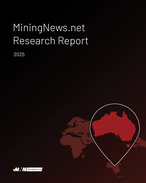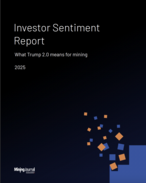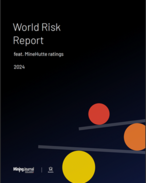This article is 12 years old. Images might not display.
Macusani Yellowcake CEO Laurence Stefan told MiningNewsPremium that first extraction was possible within six years and could transform the economy of a poor region that has traditionally relied on subsistence farming.
"The plateau is very big, almost 100km by 70km wide. Probably there are at least 50 or 60 different targets that will become mines in the future," he said.
"They would be big mines, each one of them probably producing anywhere between 20-40 million pounds - a large resource that will be developed over a long period of time of 100 years, maybe 150 years or more."
The company's first forays in Peru were in the early 2000s, drawing on archives from a British Geological Survey that had found 10 anomalies in the country - one of them on the Macusani plateau.
"It is not the usual sedimentary hosted mineralisation that you have in most countries - it's a volcanic rock called tryolite which hosts inside itself the uranium, which is very rare, because usually the uranium is deposited or segmented into sedimentary rocks," Stefan said.
Macusani Yellowcake had sealed its first three claims in the area in 2005 before it began drilling two years later with the help of Canadian investors.
"We discovered what, today, is probably one of the largest low-grade uranium resources in the world," Stefan said.
"A lot of activities took place, some of them triggered by the economic meltdown of the world in 2008 and the very low uranium price after Fukushima, and we've been able to make three mergers and acquisitions."
The company is now the largest player on its namesake plateau, which it shares with other Canadian companies Vena Resources (TSX: VEM) and Fission Energy (TSX: FIS). Drilling results have been promising for its Corachapi, Kihitian, Colibri 2 & 3, and Tupuramani deposits.
"We do believe that if everything goes according to plan that we will probably capitalise and have the right partner to develop the mine, whether it's ourselves or if we'll be able to bring in one of the large uranium players; that should take no more than five or six years from now.
"We have enough resources, we believe the continuity of the ore bodies is good and the metallurgical processing is fantastic.
"It's probably one of the cheapest uranium and ore to process anywhere in the world."
He said the mine would likely be in the lowest cost quartile of $US21 to $23 a pound, on surface in "easy" mining conditions.
The executive highlighted Macusani Yellowcake had also been lucky in terms of access, electricity and water issues. A highway connecting Brazil to Peruvian ports happens to run through its concession, water is abundant and the country's largest hydroelectric power station is just 88km away.
"Macusani is such a good uranium project, not only because it's plentiful, large and easy to mine, but it has the right infrastructure - we don't have to spend the money, we just have to connect ourselves into it."
He said pre-feasibility studies, albeit not yet bankable, were currently underway with South Africa's The Mineral Corporation and UK-based Gold and Base Metals (GBM).
"In principle we'll have a processing plant north of Colibri 2 & 3, we'll do some local mining on Colibri 2 & 3, and Tucuramani, and we'll blend with higher grade ore along the conveyor about eight kilometres transported from the mining site to the processing site from the Kihitian.
He said the uranium would be processed using heap leaching, which while not so common had been successful in places like Niger and Russia.
Stefan said the sulphuric acid used for this process would come from Peru's largest company by market capitalisation, Southern Copper Corporation (NYSE: SCCO), which has a copper smelter and sulphuric acid plant in the port of Ilo.
"Sulphuric acid is easy, and it's there available plentifully. Southern would be more than happy to provide us with one million tonnes a year if necessary."
While the fundamentals are in place, Stefan said mine advancement would be linked to government regulators.
"There is no such thing as a uranium industry or uranium mining in Peru. At present uranium is treated as a base metal, which is probably not right.
"Probably they [regulators] will ask for a lot of conditions with the mining. It's an unknown entity for Peru but we are busy with the government.
"We have talked with the congress and the local authorities to try and explain how it should work, and in principle Peru is a mining country and they have to accept that uranium is part of their heritage."
Stefan said there could be problems with communities as is the case with new industries, but Macusani Yellowcake was very close with the local people, holding workshops at least once a month to promote understanding.
"They probably ask more questions than if it were a copper deposit or a gold deposit, but we haven't encountered any type of real opposition.
"We do believe the environmental studies will be able to convince the authorities that mining uranium is not such a bad activity, and a country like Peru should probably be proud that it will become a uranium producer in half a decade or more from now.
"We do believe that mining and the services it will attract will be able to create employment for people in the area. Actually we do not have enough skills and people in the area that will be able to satisfy all the requirements of a modern mine."
*Matthew Ogg is a Santiago-based journalist.























